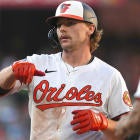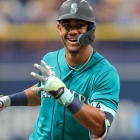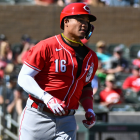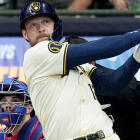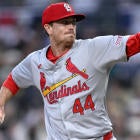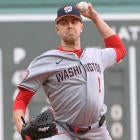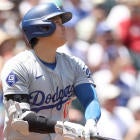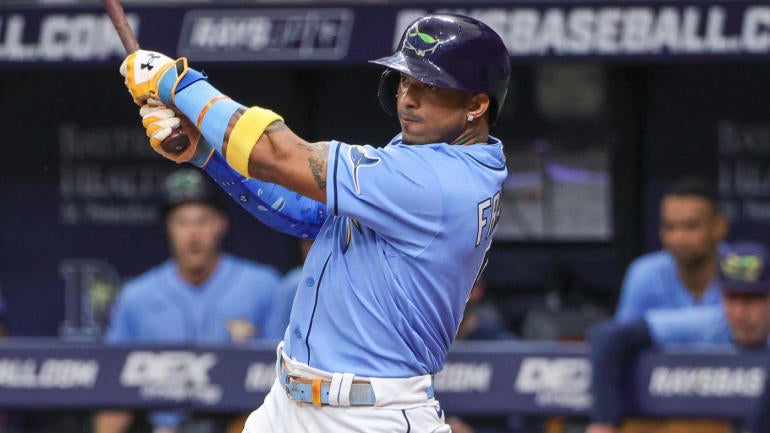
The start of spring training is an exciting time for the Fantasy Baseball enthusiast. We haven't seen a major-league baseball game that matters since Nov. 5, when the Astros closed out the Phillies to win the World Series last year, which means we're close to four months removed from the last time we saw any of these guys in action.
We're starved for information as we get ready for the start of the 2023 season. And, with players reporting to camp this week and spring games officially kicking off Friday, we're about to see real baseball games. I mean … not, you know, real baseball games that matter, but real information, at least.
And 2023 is one of those extra-fun years where we're going to get games that actually kind of matter, because the World Baseball Classic is set to kick off March 7 and run for two weeks, with some of the biggest names in the sport taking part. And, while there are rules that ensure the WBC won't be played exactly like regular season baseball – pitchers, for example, are prohibited from through more than 95 pitches at any point, with stricter limits early in the tournament – the players don't just treat it like an exhibition match, clearly:
This is, potentially, a perfect storm for preseason overreactions and overanalysis. There is always a tendency to overreact to meaningless spring training chatter – so much so that "best shape of my life" stories are practically a meme by now. You need to guard against meaningless spring narratives, and you probably don't need to care too much about actual spring performance, either. I mean, sure, all other things being equal, you'd rather a player perform well in spring training. But we're generally talking about sample sizes in the double-digits in plate appearances and in the low dozens of innings over the course of the spring, against wildly varying levels of competition, so there's limits on how much you can learn from them in the best of cases.
But that doesn't mean you don't need to pay attention to what's going on in spring training. You just need to know what to pay attention to.
Do I care if some beat writer thinks Robbie Ray looked "electric" during a bullpen session in February? Not particularly, and neither should you. However, the fact that Ray is working on a new pitch definitely piqued my interest in recent days. At this point, we don't actually know what that pitch will be – The Athletic's Corey Brock speculates it is a splitter – let alone how effective it will be, but that's the kind of detail you should be looking out for during spring training.
Over the course of the next few weeks leading up to Opening Day, we'll be analyzing what we're hearing from spring and what we're seeing in games, both at CBSSports.com/Fantasy and on the Fantasy Baseball Today podcast. But I want to give you a guide for what to keep an eye out for as the reports start to come in. Let's separate the signal from the noise.
Here are the key things I'm looking for during the spring:
- Injuries
- Lineup News
- Position Battles
- Velocity Readings and New Pitches
- Prospects Gaining Hype
Let's go through each one to explain why they matter, roughly in order of importance:
Injuries
Well, this one is pretty obvious. Injuries are bad, both because they keep players off the field, and also – and, perhaps more importantly – because of the lingering effects they can have on player performance in the future.
I tend to be a bit less concerned about injury risk than most Fantasy analysts, but that is much less true about players who suffer injuries during the spring. That's not to say I'm going to freak about every sprained ankle or early-spring conditioning issue. Teams are naturally pretty conservative about injuries at this time of year, so even Jacob deGrom's side issue isn't concerning me – yet.
However, if deGrom isn't ready to go in a few days, it'll start to be a bit more of a concern. But the bigger issue is something like Red Sox pitching prospect Brayan Bello's forearm issue. He has been shut down from throwing for a few days with "tightness," and while he and the team has downplayed it so far, I'm less likely to throw a late-round dart at Bello right now. Forearm issues have a tendency to lead to elbow issues, and elbow issues have a tendency to ruin seasons.
Bello is going late enough, generally, that there isn't much risk in that dart throw, and it's possible he gets back on the mound in the next few days without issue and enjoys a breakout season. But, if his prep for the season continues to get delayed, it's going to make it harder for him to get on track, earn a rotation spot, and thrive.
Basically, I don't want to see a player's reps too limited because of injury during the spring. That matters less for established players, so concerns there are more about availability.
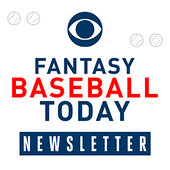
Fantasy Baseball Today Newsletter
Your Cheat Code To Fantasy Baseball
You're destined to gain an edge over your friends with advice from the award-winning FBT crew.
Thanks for signing up!
Keep an eye on your inbox.
Sorry!
There was an error processing your subscription.
Velocity readings and new pitches
This is one of the key things we'll keep track of. Velocity, unlike a lot of spring stats, stabilizes very quickly, so if a pitcher comes out throwing 2 mph harder than usual, that's notable. It doesn't necessarily mean that the pitcher will be better, but it's usually a pretty good indicator.
I will caution against overreacting to lower velocity readings than we're used to, especially early on in spring. Lower velocity can be a sign of impending injury, but it's also usually going to lead to worse performance. Not always, of course, and even when it does, it doesn't mean a player is doomed to Fantasy irrelevance – something I predicted for Shane Bieber at this time last year, only to look like a fool. However, lower velocity is a red flag, for sure.
New pitches are trickier, because there's no guarantee any new pitch will actually be an effective one. In fact, a change in pitch repertoire could potentially even lead to unintended consequences, if the pitch is bad or makes the rest of the pitchers pitches less effective. Or, sometimes, it just ends up being a non-factor, like when Tyler Glasnow was working on a splitter in 2020 that never really materialized.
So, we'll focus more on velocity readings in spring, for the most part, while keeping an eye out for reports of new pitches that could help unlock things for established pitchers. One I'm interested in watching in spring is Jameson Taillon, who is working on his repertoire to give him another pitch to put hitters away. Taillon has always had the talent, and he does a pretty good job of limiting hard contact, but he's never been able to rack up strikeouts well enough to take the next step. If he can up his swing-and-miss rate thanks to this new pitch, there's still some breakout potential here.
Lineup news
It's possible to overreact to lineup news in spring training, especially when it comes to spring lineups – is a player batting leadoff in the exhibition games because that's where he is going to hit when the season starts, or is it because the team wants to get him as many game reps as possible? Figuring that out can be a key.
That being said, lineup position matters quite a bit. Last season, the No. 1 spot in the order averaged 742.5 plate appearances per team across the majors, while the No. 5 spot averaged 677 and No. 9 was down at 600.6. That's about a 10% difference between the leadoff spot and the No. 5 spot, which is pretty massive.
Think about someone like Dansby Swanson last season and the impact that had on him. He had career-highs in runs and RBI, at least in part thanks to hitting near the top of the lineup more consistently.
Someone like Masataka Yoshida's value is going to depend heavily on whether he hits at the top of the Red Sox lineup or not. He projects to be a solid hitter, but one with pretty middling power, and he probably won't run much. However, if he's at the top of the lineup and can project for 95-plus runs, it's a profile that starts to look a lot more enticing than it otherwise would be.
One thing to keep in mind, of course, is that lineups are just snapshots of where a team is at any given point in time. Just because a player starts the season as a leadoff hitter doesn't mean they'll stay there; they still have to hit well to keep the spot, and most teams will go through many different variations of lineup throughout the season. But, all else being equal, you'd rather see a guy trending for a top-of-the-lineup spot in spring.
Position battles
This is an obvious one, and it applies to both pitchers and hitters. We'll have more in the coming days on the top position battles to watch across the league, but here are just a few to keep an eye on right now:
- Cardinals OF/DH: Lars Nootbaar vs. Jordan Walker vs. Dylan Carlson vs. Tyler O'Neill vs. Juan Yepez
- Diamondbacks catcher: Gabriel Moreno vs. Carson Kelly
- Yankees shortstop: Oswaldo Peraza vs. Isiah Kiner-Falefa
- Phillies No. 5 starter: Bailey Falter vs. Andrew Painter
- White Sox OF: Oscar Colas vs. Gavin Sheets
Generally speaking, there's a young, exciting guy we're rooting for in each spot, which brings us to …
Prospects gaining hype
It's easy to get too hyped about prospects, but it's also true that prospects making their MLB debut are a rare opportunity to buy a potentially elite performer for much less than they would otherwise cost in drafts. Sometimes, we go overboard in overhyping young guys – Wander Franco probably qualifies to date, to name one – but prospects are still worth chasing for the potential that they'll way over perform their cost.
You should make yourself familiar with Scott White's top-100 prospects list for the next crop of high-end young players to take the Fantasy world by storm, but Jordan Walker, Oscar Colas, and Andrew Painter are certainly some of the guys who have a chance to force their way onto the Opening Day roster for their respective teams. Anthony Volpe, Grayson Rodriguez, Francisco Alvarez, Miguel Vargas, and Bretty Baty all fall into the category of prospects to watch, but there are also going to be a few guys who could accelerate their timelines with a big spring – Fernando Tatis and Chris Paddack are two who did that with the Padres a few years ago, and with rule changes meant to incentivize teams to be more aggressive in promoting top prospects, we could see more like that in future years.
One name I'm keeping a close eye on is Marlins prospect Eury Perez. He's a true long shot to crack a deep rotation, but the soon-to-be 20-year-old held his own at Double-A last season and could be in the discussion early on if he impresses this spring.









